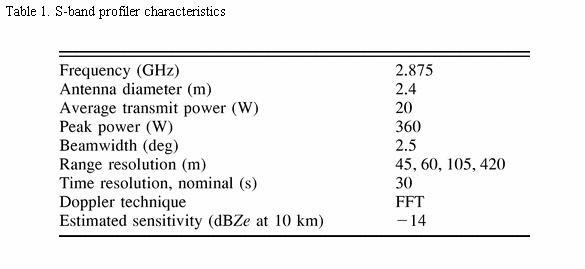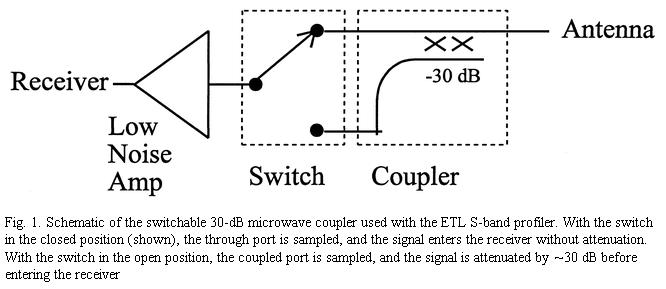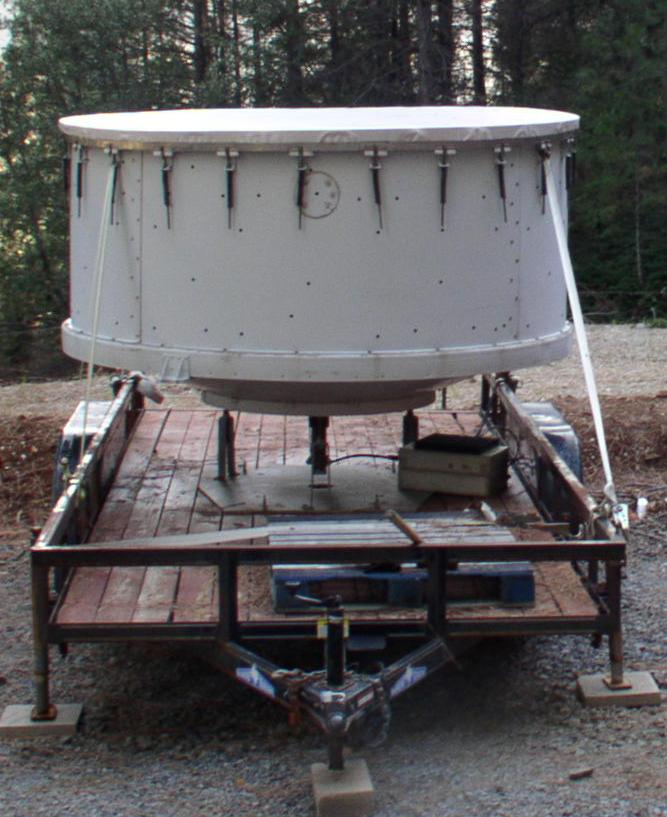S-Band Precipitation Profiler
Introduction
In general, a radar's sensitivity to small particulates increases as the transmitted wavelength, lambda, decreases and as transmitted power, antenna size, beam sample volume size, and integration time increase. Similar arguments can be made for backscatter from clear-air turbulence, keeping in mind the much weaker wavelength dependence that exists in this scattering regime. Although the Rayleigh lambda^-4 backscattering dependence favors the use of shorter wavelength radars for cloud observations, even longer wavelength radars, such as UHF wind profilers (~33.75 cm) have demonstrated some ability to detect clouds (Orr and Martner 1996; White et al. 1996). The main advantage of short-wavelength systems such as millimeter-wave radars (e.g., Moran et al. 1998) is their ability to obtain excellent sensitivity and spatial resolution without the use of large antennas or very powerful transmitters. Also, ground clutter is less of an issue at shorter wavelengths (Kropfli and Kelly 1996). Their primary disadvantage is severe attenuation by rain (but not by snow).
Operational precipitation surveillance has long been the province of centimeter-wavelength radars in the United States. Recently, the National Oceanic and Atmospheric Administration (NOAA) Aeronomy Laboratory combined wind profiler technology with S-band (lambda = 10 cm) radar hardware to create a new precipitation profiler (Ecklund et al. 1999). These profilers have amply demonstrated an ability to continuously monitor precipitation echoes overhead and have also indicated a substantial ability to observe at least the more strongly reflecting regions of clouds. The enhanced sensitivity necessary for cloud profiling is achieved by coherently integrating the received signals and by pulse coding the transmitted pulses to boost the average signal power.
In this regard, an S-band profiler bridges the gap that exists between millimeter-wave cloud radars, which reveal the structure of extremely weak, nonprecipitating clouds but are severely attenuated by rainfall, and operational weather radars, which, although unattenuated by rain, generally lack the sensitivity to detect much cloud structure. This article describes a new S-band profiler built by the NOAA Earth System Research Laboratory's Physical Sciences Division (PSL) that uses a switchable microwave coupler to extend the profiler's dynamic range in order to bridge this gap even more thoroughly. After a brief description of the radar and how it was calibrated, examples from recent field experiments are shown to elucidate the profiler's measurement capabilities.
Radar Description
The prototype for the PSL S-band profiler was built at the NOAA Aeronomy Laboratory (Ecklund et al. 1999). The PSL profiler uses a different antenna feed that consists of a rectangular waveguide and a splash plate. The splash plate is welded to the top of the waveguide without any other supporting structure. The dish is fully illuminated, resulting in a one-way, 2.5 degree beamwidth (full-width at half-maximum power). Additional characteristics of the profiler are listed in Table 1 . Excluding the paraboloid antenna, much of the design of the radar hardware and signal processing software is based on the existing technology used in the 915-MHz wind profilers (Carter et al. 1995).

The radar receiver uses 8-bit, in-phase, and quadrature digital converters, which limit its dynamic range to 45 dB. Doppler signal processing adds an additional 22 dB. Therefore, the total dynamic range of the profiler is 67 dB. We have detected this range in the laboratory using a sinusoidal signal, but the dynamic range apparent in field measurements will always be less. The primary reason is that the probability density function for the intensity (or power) of atmospheric signals (in clear air and in precipitation) is exponential. This makes the concept of a saturation threshold somewhat ambiguous because, for a finite dwell time, some of the instantaneous signals will saturate the receiver.
We added a switchable, 30-dB coupler to the receiver to extend the dynamic range of the PSL S-band profiler. A coupler is a microwave device that allows most of the power to pass through one port, called the through port, with little attenuation. A small amount of the power (one thousandth, in this case) traveling in the forward direction is diverted to a second port, called the coupled port. We placed the coupler and a switch, to select between the through port and the coupled port, before the first low-noise amplifier in the receiver (see Fig. 1 ). This configuration adds only 0.2 dB of loss to the receiver. The receiver noise level changes by about 10% when switching between the coupled mode and the noncoupled mode. Accordingly, we can switch between modes without recalibrating the receiver.

The microwave coupler and switch are simple and relatively inexpensive additions to the radar receiver. Yet we are unaware of any other attempts to use this technology to increase the dynamic range of a meteorological radar, making the coupler a unique feature of the PSL S-band profiler. Another option for increasing dynamic range is to use a logarithmic receiver. This method increases dynamic range but sacrifices sensitivity unless an additional linear receiver is sampled. By programming the S-band profiler to alternate between coupled and noncoupled operating modes, the dynamic range is increased using a single receiver and without sacrificing sensitivity.
Bibliography
Carter, D. A., K. S. Gage, W. L. Ecklund, W. M. Angevine, P. E. Johnston, A. C. Riddle, J. S. Wilson, and C. R. Williams, 1995:Developments in UHF lower tropospheric wind profiling at NOAA.s Aeronomy Laboratory. Radio Sci., 30, 997.1001.
Ecklund, W. L., C. R. Williams, P. E. Johnston, and K. S. Gage, 1999:A 3-GHz profiler for precipitating cloud studies. J. Atmos. Oceanic Technol., 16, 309.322.
Kropfli, R. A., and R. D. Kelly, 1996: Meteorological research applications of mm-wave radar. Meteor. Atmos. Phys., 59, 105. 121.
Moran, K. P., B. E. Martner, M. J. Post, R. A. Kropfli, D. C. Welsh, and K. B. Widener, 1998: An unattended cloud-profiling radar for use in climate research. Bull. Amer. Meteor. Soc., 79, 443. 455.
Orr, B. W., and B. E. Martner, 1996: Detection of weakly precipitating winter clouds by a NOAA 404-MHz wind profiler. J. Atmos. Oceanic Technol., 13, 570.580.
White, A. B., C. W. Fairall, A. S. Frisch, B. W. Orr, and J. B. Snider, 1996: Recent radar measurements of turbulence and microphysical parameters in marine boundary layer clouds. Atmos. Res., 40, 177.221.
Publications
Extending the Dynamic Range of an S-Band Radar for Cloud and Precipitation Studies
A 3-GHz Profiler for Precipitating Cloud Studies
A Comparative Study of Rainfall Retrievals Based on Specific Differential Phase Shifts at X- and S-Band Radar Frequencies

 The radar receiver uses 8-bit, in-phase, and quadrature digital converters, which limit its dynamic range to 45 dB. Doppler signal processing adds an additional 22 dB. Therefore, the total dynamic range of the profiler is 67 dB. We have detected this range in the laboratory using a sinusoidal signal, but the dynamic range apparent in field measurements will always be less. The primary reason is that the probability density function for the intensity (or power) of atmospheric signals (in clear air and in precipitation) is exponential. This makes the concept of a saturation threshold somewhat ambiguous because, for a finite dwell time, some of the instantaneous signals will saturate the receiver.
We added a switchable, 30-dB coupler to the receiver to extend the dynamic range of the PSL S-band profiler. A coupler is a microwave device that allows most of the power to pass through one port, called the through port, with little attenuation. A small amount of the power (one thousandth, in this case) traveling in the forward direction is diverted to a second port, called the coupled port. We placed the coupler and a switch, to select between the through port and the coupled port, before the first low-noise amplifier in the receiver (see Fig. 1 ). This configuration adds only 0.2 dB of loss to the receiver. The receiver noise level changes by about 10% when switching between the coupled mode and the noncoupled mode. Accordingly, we can switch between modes without recalibrating the receiver.
The radar receiver uses 8-bit, in-phase, and quadrature digital converters, which limit its dynamic range to 45 dB. Doppler signal processing adds an additional 22 dB. Therefore, the total dynamic range of the profiler is 67 dB. We have detected this range in the laboratory using a sinusoidal signal, but the dynamic range apparent in field measurements will always be less. The primary reason is that the probability density function for the intensity (or power) of atmospheric signals (in clear air and in precipitation) is exponential. This makes the concept of a saturation threshold somewhat ambiguous because, for a finite dwell time, some of the instantaneous signals will saturate the receiver.
We added a switchable, 30-dB coupler to the receiver to extend the dynamic range of the PSL S-band profiler. A coupler is a microwave device that allows most of the power to pass through one port, called the through port, with little attenuation. A small amount of the power (one thousandth, in this case) traveling in the forward direction is diverted to a second port, called the coupled port. We placed the coupler and a switch, to select between the through port and the coupled port, before the first low-noise amplifier in the receiver (see Fig. 1 ). This configuration adds only 0.2 dB of loss to the receiver. The receiver noise level changes by about 10% when switching between the coupled mode and the noncoupled mode. Accordingly, we can switch between modes without recalibrating the receiver.
 The microwave coupler and switch are simple and relatively inexpensive additions to the radar receiver. Yet we are unaware of any other attempts to use this technology to increase the dynamic range of a meteorological radar, making the coupler a unique feature of the PSL S-band profiler. Another option for increasing dynamic range is to use a logarithmic receiver. This method increases dynamic range but sacrifices sensitivity unless an additional linear receiver is sampled. By programming the S-band profiler to alternate between coupled and noncoupled operating modes, the dynamic range is increased using a single receiver and without sacrificing sensitivity.
The microwave coupler and switch are simple and relatively inexpensive additions to the radar receiver. Yet we are unaware of any other attempts to use this technology to increase the dynamic range of a meteorological radar, making the coupler a unique feature of the PSL S-band profiler. Another option for increasing dynamic range is to use a logarithmic receiver. This method increases dynamic range but sacrifices sensitivity unless an additional linear receiver is sampled. By programming the S-band profiler to alternate between coupled and noncoupled operating modes, the dynamic range is increased using a single receiver and without sacrificing sensitivity.